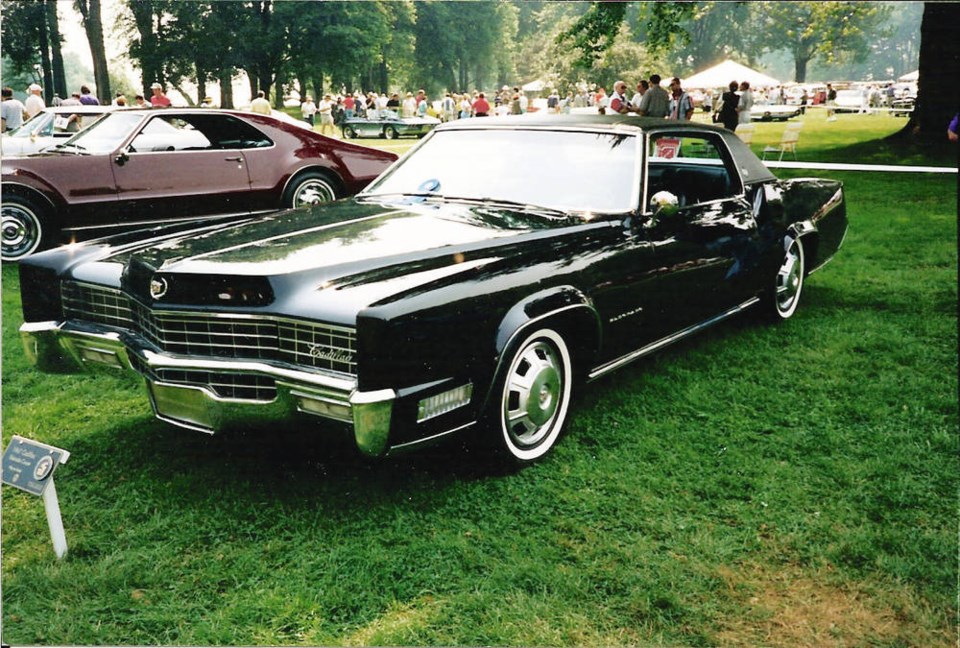From the arrival of the original ultra luxurious limited production Cadillac Eldorado in 1953 the Eldorado was always an image-enhancing model for Cadillac. While having a special place in Cadillac’s lineup, its greatest transition came when it went from rear-wheel drive to front-wheel drive in 1967. It was a clone of the 1966 Oldsmobile Toronado that arrived a year earlier.
Although front-wheel drive is popular now it was a novelty in North America in the 1960s. It had been used by American Walter Christie of New York early in the century, and Ruxton and Cord in the 1920s and ’30s, but was still viewed as something found on foreign cars. The Europeans had been more daring with such marques as Audi, Citroen, Saab and British Motor Corp. (Austin/Morris Mini) using it successfully.
Serious use of front-wheel drive did not begin in North America until the 1960s when Oldsmobile introduced it in their luxurious new 1966 Toronado model. Europeans favoured front drive for its space and fuel efficiency but neither seemed high on Oldsmobile’s agenda, although the lack of a transmission hump did make it a true six passenger car.
The 1966 Toronado was big and weighed some 2,041 kg (4,500 lb) with a 3,023 mm (119 in.) wheelbase and 5,359 mm (211 in.) length. It had a 7.0 litre (425 cu in.) overhead valve, 385 horsepower V-8, causing some sceptics to predict that front drive would not work satisfactorily in such a large, powerful car. But they were wrong, and it proved reliable and sturdy enough for General Motors to use as the driveline in its GMC motor home.
Cadillac introduced the Fleetwood Eldorado version of the Toronado a year later, and although large by today’s standards, it was then the smallest Cadillac.
General Motors achieved front drive by mounting the torque converter in its normal place at the rear of the longitudinally positioned V-8. The separate transaxle was rotated 180 degrees to the left side of the engine and drove the three-speed Hydra-Matic transmission via a 51 mm (2 in.) wide chain.
Because conventionally positioned coil springs would interfere with the drive axles, front suspension was by longitudinally positioned torsion bars. At the rear a simple beam axle was mounted on single-leaf, semi-elliptic springs controlled by four shock absorbers, two vertical and two horizontal.
Cadillac adapted its 7.0 litre (429 cu in.) V-8 for front drive use by modifying such items as the oil pan, engine mounts and exhaust manifold.
The Olds wheelbase was stretched 25 mm (1 in.) to 3,048 mm (120 in.). Standard self- levelling rear suspension and variable-ratio power steering were included.
The long hood, short deck configuration somehow looked more elegant on the Caddy than on the Olds. Cadillac stylists softened the muscular look of the Toronado’s wide-shouldered wheel flares and emphasized length by extending the front and rear fenders in sharp knife-edge lines.
The Eldorado was well received by the motoring press. Automobile Quarterly gave the Eldo its design and engineering excellence award, and Car Life described it as a “visually distinctive, tastefully luxurious, enormously expensive conveyance.” Motor Trend said the Eldorado’s build quality equalled anything from Mercedes-Benz, BMW or Rolls-Royce. They reported zero to 97 km/h (60 mph) in 10.0 seconds and a top speed of 201 to 209 km/h (125 to 130 mph).
To ensure a level of exclusivity Cadillac planned to keep the number of Eldorados built below 10 percent of the division’s total production. The just fewer than 18,000 first year Eldos built sold out quickly.
The 1968 Eldo was largely unchanged, although the engine was increased to 7.7 litres (472 cu in.). Hidden wipers made the already long hood appear even longer, and the buying public ordered 24,528 of them.
Content with a good thing, Cadillac slid the Eldo into 1969 with minor alterations. The headlamps were now exposed and the grill had slimmer bars. Safety concerns brought such items as side-impact door beams, an energy absorbing steering column and front-seat headrests.
In 1970, the last year for the first generation Eldorado, it got yet another increase in engine size to a whopping 8.2 litres (500 cu in.), North America’s largest automobile powerplant. Needless to say, fuel economy concerns were still a few years in the future. Production was 23,842 1970 models, similar to 23,333 of the year before.
The second generation version would bow for 1971, and the Eldo would go through many iterations, growing even bigger before getting smaller, and ultimately becoming an even higher tech, more sophisticated automobile. The Eldorado, still with front-wheel drive, was discontinued in 2002.
While those first big front-wheel drive Eldorados would seem out of place in today’s environmentally concerned world, in the pre-downsizing era they were regarded as the epitome of American automotive luxury.



